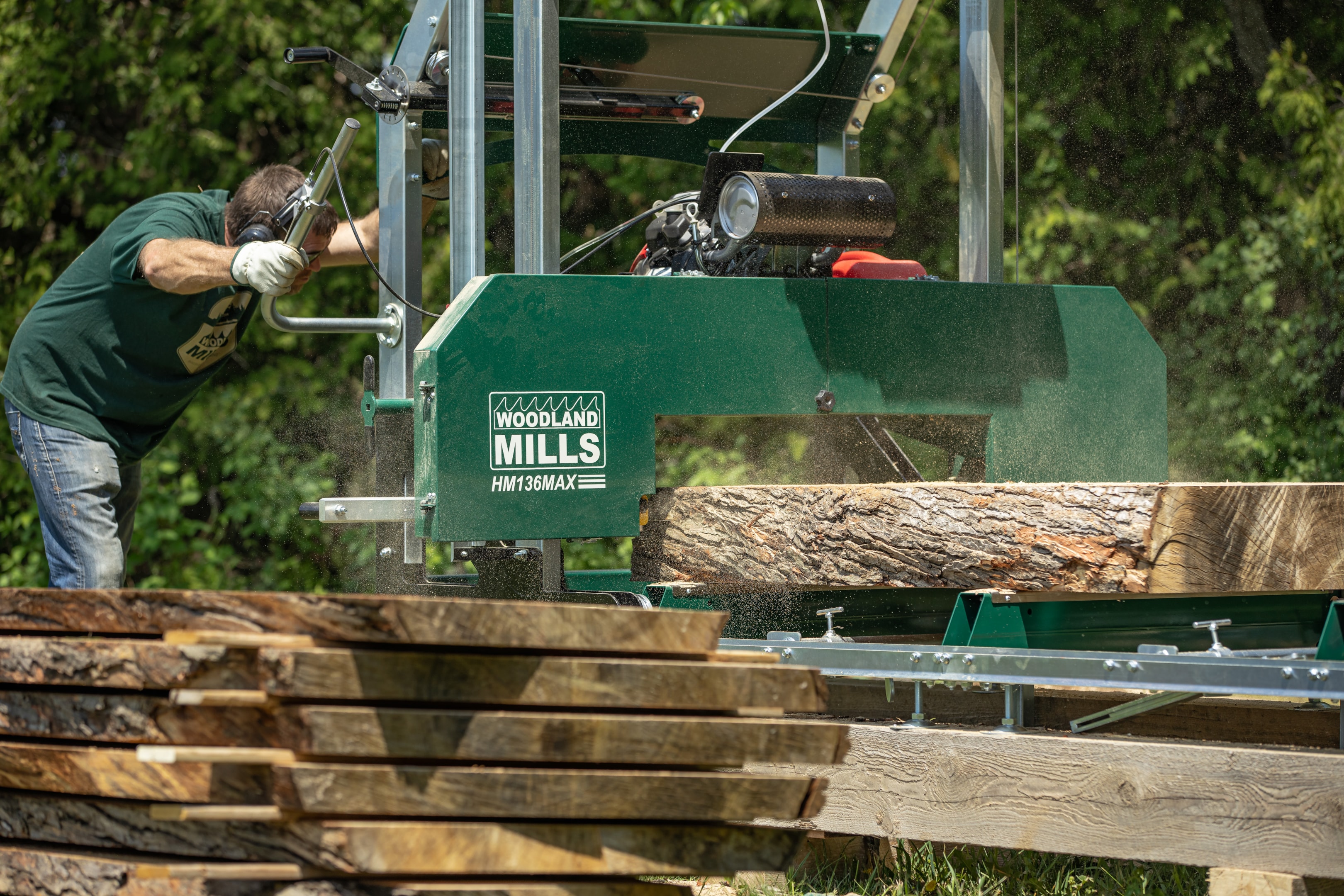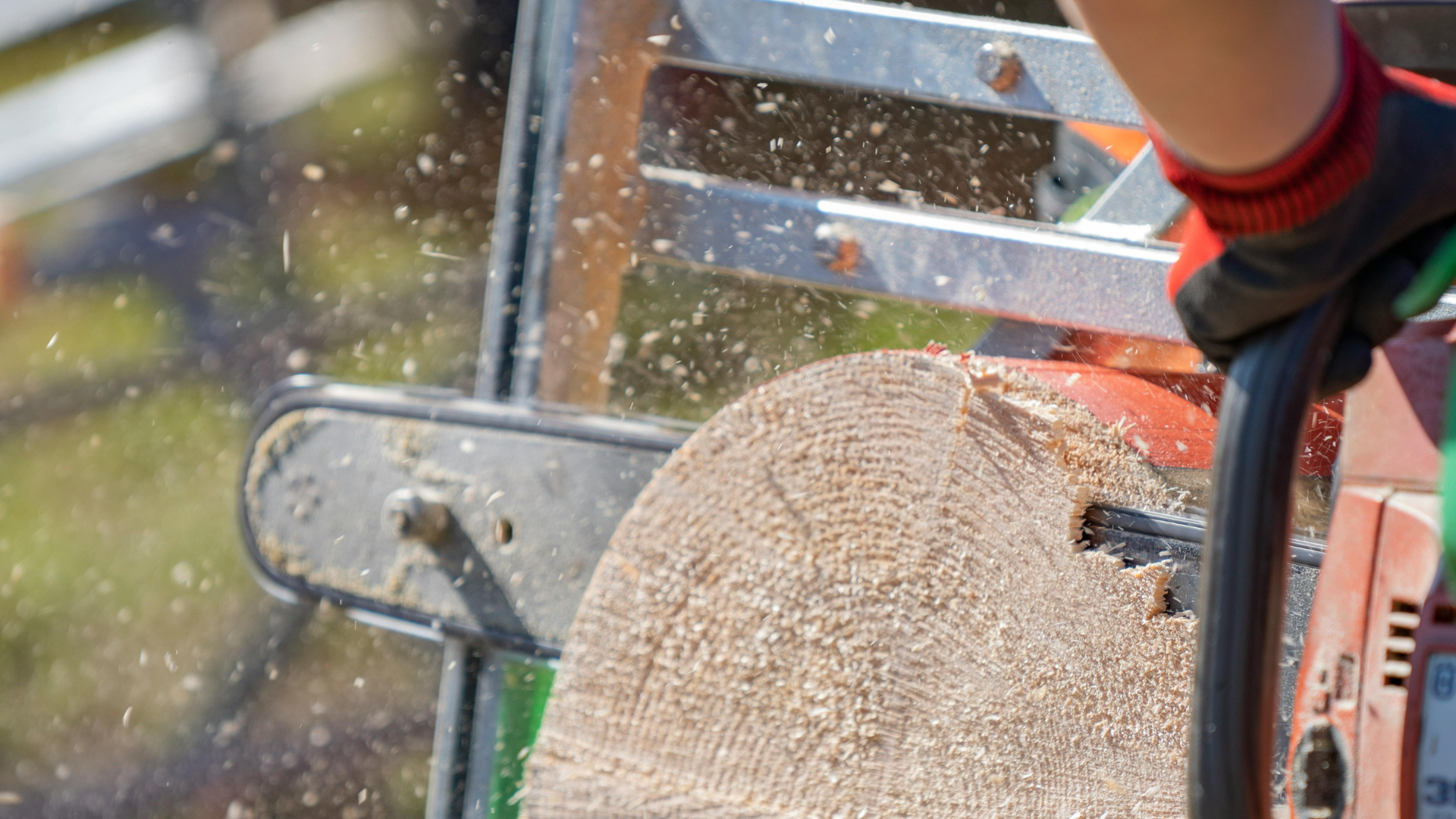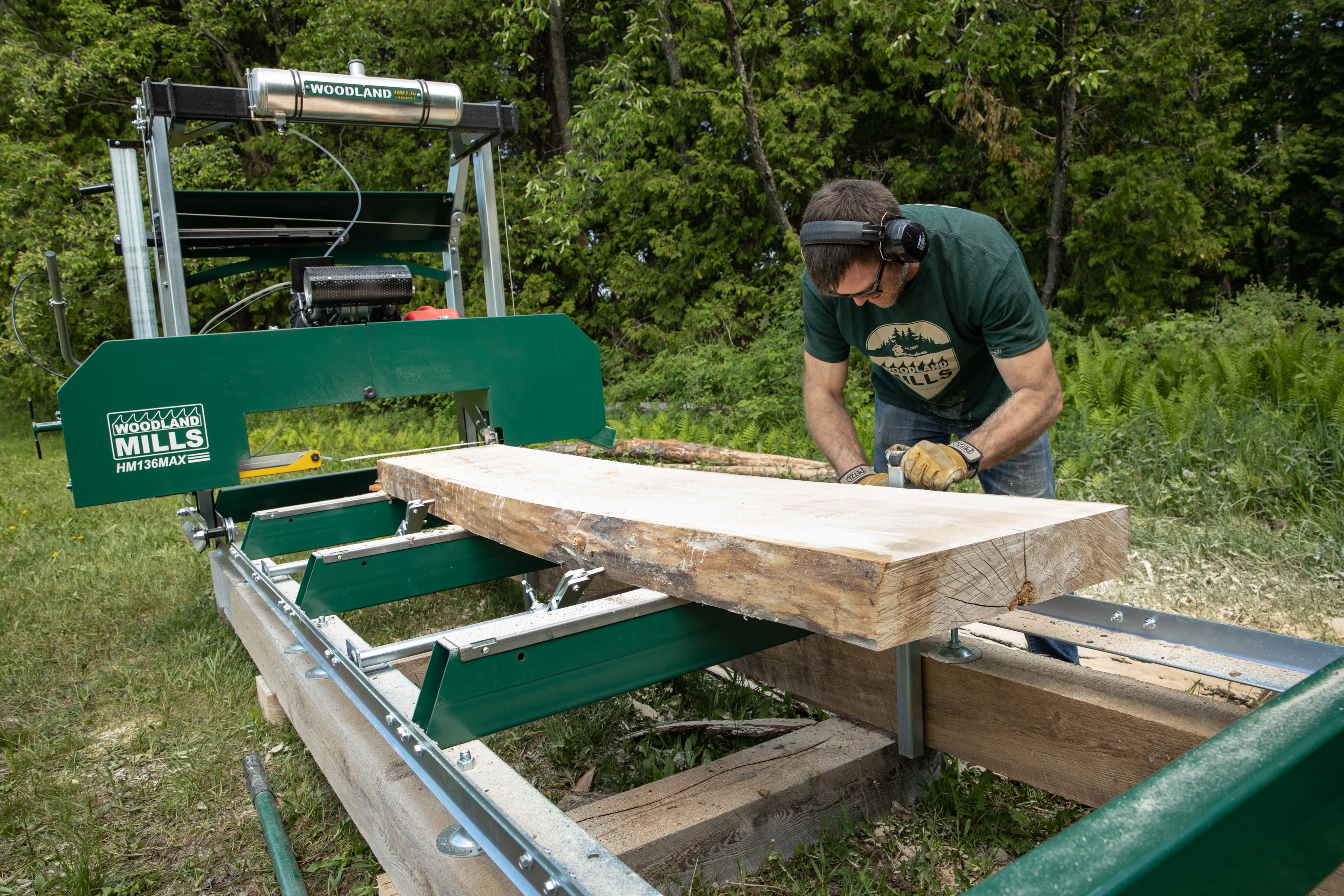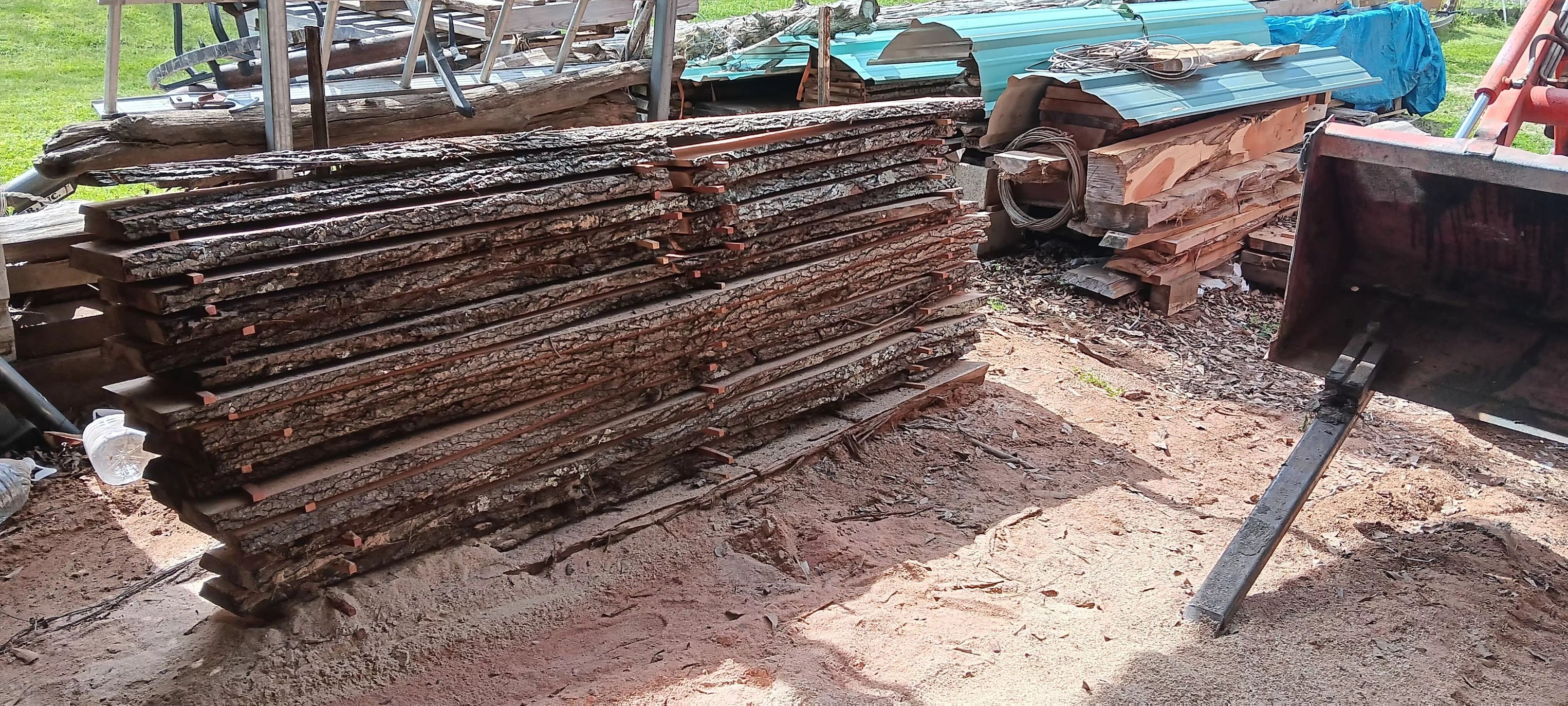Chainsaw Mill vs Bandsaw Mill: Which is Better for You?
Want to make your own lumber but don't know where to start? Let's go over which machine is best for you
Do you want to mill your own lumber?
Having a machine that can mill logs into dimensional lumber, slabs or posts can be incredibly useful, but it can be hard to determine which is the best tool for the job.
Chainsaws are a ubiquitous forestry tool that nearly every woodworker, arborist and property owner has, but a bandsaw mill is a specialty tool that can easily convert logs into any type of lumber. Bandsaws are known for their speed and precision, making them popular for production-scale milling.
The main difference between chainsaw mills and band mills is in their speed, cut quality, and efficiency. Understanding this difference is key to choosing the right tool for your needs.
Let’s go over the basics of what sets these two types of machines apart.

What is a bandsaw mill?
A bandsaw mill is a precise tool used to mill logs. They are used for all sizes of logs and are designed with a thin kerf so there’s little wasted material. Band sawmills are sometimes just called band mills, and are specifically lumber milling tools.
One of the main draws of a bandsaw mill is that they can easily mill most sizes of logs just as easily, and require less manual labor. You can also add extra accessories to your sawmill to upgrade its track size.
Some of the advantages to using a bandsaw mill:
-
-
Less manual labor
-
Less material wasted from the kerf
-
If it can fit on the track you can mill it
-
What is a chainsaw mill?
A chainsaw mill, such as an Alaskan mill, turns your chainsaw into a makeshift sawmill. Using a rip chain and specialized chainsaw bar, some sawyers use these to mill lumber.
Because the bar length is the main factor for the size of logs you can mill that means you can only mill up to the size of your chainsaw. Milling typically starts from one end of the log and proceeds along its length.
It’s common practice for sawyers to start milling lumber by using a chainsaw and eventually upgrade to a bandsaw mill.
The pros of chainsaw milling include:
-
-
Low upfront cost, you may already own a chainsaw
-
High portability
-
More manual labor intensive
-
Reasons for Milling Lumber
There are a lot of great reasons why you’d want to have the ability to turn your tree into milled material. Whether you’ve got plans to build furniture and need some hardwood lumber or you want to mill some pine for framing in a structure, having the opportunity to make your own lumber opens so many doors. Milling your own lumber allows you to produce high-quality boards for your projects, ensuring precise and smooth cuts.
-
-
You can mill to exact dimensions you need
-
You can mill high quality wood and don’t have to worry about getting knotty lumber from the hardware store
-
You can use the off-cuts for side projects, or use them as firewood, or chip them for a supply of wood chips
-
You can often mill your own wood for cheaper than you can buy it
-
You can offer to mill others’ lumber to recoup your investment
-
You can mill a bunch of smaller logs for construction or woodworking projects, making use of timber that might otherwise go to waste
-

The Differences Between Chainsaw Mills and Bandsaw Mills
So which of these two machines do you want to use to cut logs? When considering sawmilling, it's important to compare the speed of band mills, which generally cut faster, to chainsaw mills, which are slower but more portable. The weight of the equipment also matters—lighter mills are easier to move, while heavier mills offer more stability.
Additionally, the width of logs or boards each mill can handle is a key factor, as it determines the maximum size of lumber you can produce. Do you want to use a chain mill or invest in a larger piece of equipment? Let’s go over the benefits of both.
Portability
A chainsaw and an Alaskan Mill rig can easily fit in the back of your truck. Just haul it to the job site and easily turn your logs into lumber on the spot.
A portable sawmill can also come on a trailer and hitch to the back of your truck to mill on-the-go. And the upside with that is that it’s easier to load and mill heavy logs and do the big stuff with a bandsaw mill than a chainsaw.
Effort
When you’re on your knees pushing a chainsaw through a lot, especially if you’re doing bigger logs, you may wonder if there’s an easier solution.
A portable sawmill requires much less effort. While you do have to roll the logs onto the track and flip them over to mill cants, after your first cut you’ll realize how much easier it is than chainsaw milling. Using a portable sawmill can make milling not only easier, but it can also change your woodworking life by giving you more independence and opening up new possibilities for your projects.
Capacity
With a chainsaw mill your capacity is determined by your bar size. Want to mill a larger log? Just install a larger bar and you’re good to go, just make sure you have a larger bar available.
On a portable sawmill your capacity is determined by the size of the track and sawhead. You can always add track extensions to mill larger logs, but it’s more difficult to mill logs with a larger diameter than your mill allows, meaning you may have to trim material off for it to fit.
Cost
When it comes to purchasing equipment you want to be smart with your money. Chainsaws are a low upfront investment and oftentimes are a piece of equipment you may already own. You may also have to purchase a rig to do Alaskan milling to ensure your cuts are straight and consistent.
Portable sawmills meanwhile have a higher upfront investment, but one of the main draws is how much time and effort it saves you. With a bandsaw mill you can afford bending over and doing backbreaking milling and can more quickly get through one log and onto the next.
Budget is an important consideration but don't forget to think about the ways that paying in advance can save you money in the future.
Maintenance
One of the great things about chainsaws is that they’re cheap to run and maintain. Just fill it with gas, check and refill the bar oil, and sharpen it when the chain dulls.
Portable sawmills are also designed with few maintenance points. Just keep the engine oiled and fueled, regularly check and top up the lubrication oil, make sure the sawhead is clean of obstructions and sawdust, and follow all the steps in the owner’s manual and you should be able to keep it running for years to come.

So do you want a sawmill or chainsaw?
Still undecided? While there are advantages to both sawing methods, here is a breakdown of when each one might be most appropriate. Choosing the right mill can save you money in the long run by reducing labor and material costs, and can have a significant impact on your overall project budget.
When do I need a bandsaw mill?
The pros of portable bandsaw mills includes:
-
-
Efficiently handles larger logs
-
Consistent results from smaller logs
-
Clean cuts with minimal waste, meaning less wasted lumber
-
More ergonomic operation
-
Portable sawmills are great for high volume lumber production, when you need accurate, consistent cuts multiple times, such as when doing dimensional lumber and when you have specific projects in mind.
They're also great for larger diameter material and are the better option for sawyers who plan on consistently producing lumber, such as those who own woodlots or do construction projects like building houses.
When do I need a chainsaw mill?
The pros of chainsaw mills includes:
-
-
Adjustable rip chain for different cuts
-
Flexible chainsaw bar options
-
Easy storage when not in use
-
Sufficient for occasional projects
-
An Alaska mill setup makes sense if you’re doing the odd milling project, if you want to dedicate the smallest amount of space to cutting lumber and if you’re already using your workshop or truck space for other wood processing machines.

Which is better, a chainsaw mill or a bandsaw mill?
At the end of the day, the best lumber cutting machine is the one that serves your needs best.
Both chainsaw mills and bandsaw mills are types of saws used for milling lumber, each offering unique strengths for different projects. Both types of mills can be used in the woods or on-site for convenience, allowing you to mill logs directly where the trees are felled.
If you’re doing the occasional woodworking project and don’t want to invest too much in upfront costs, then put your chainsaw to use and transform your wood into lumber. While your wood may require further processing, it’s an easy way to mill your own wood.
If you want a serious machine dedicated to turning wood into lumber, want to see less sawdust and want consistent results each time you may want to consider a portable sawmill. These machines can easily turn your trees into whatever material you need for your next project. Many sawyers say they see a return on their investment many times over.
SHOP SAWMILLS
HM122
An entry-level sawmill packed with impressive features at a budget-friendly price. Designed for hobby sawyers or woodworkers looking for an economical solution to mill lumber.
HM126
One of the best-valued sawmills in the industry. A longstanding favourite that ensures smooth, accurate cuts. Perfect for hobby sawyers, entrepreneurs or seasoned woodworkers.
HM130MAX®
A wide capacity sawmill that produces stunning high-value live-edge boards. Loaded with features including our FULLCUT™ sawhead, RapidChange® blade system, auto lube, and more.
HM136MAX™
The ultimate solution for cutting wide live edge slabs, perfect for tabletops, counters, benches, and more. Our unique FULLCUT™ sawhead design ensures your logs' widest assets are left intact.
Join the Woodland Mills Community Facebook group. Search advice and insights from over 65,000 knowledgeable, supportive members.
- Pre-purchase considerations
- Sawmill set-up support
- Project inspiration photos and videos
- Community troubleshooting support
